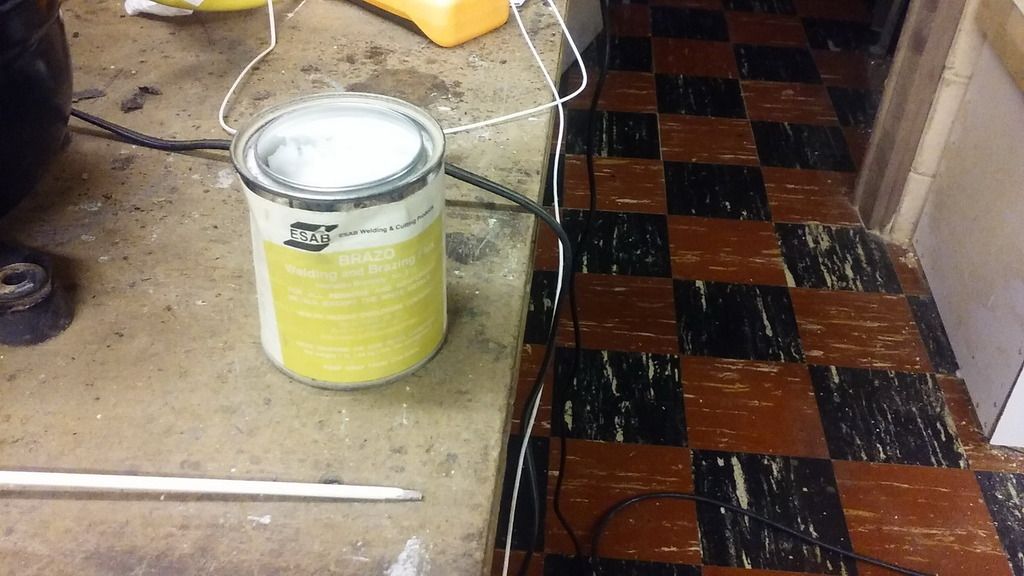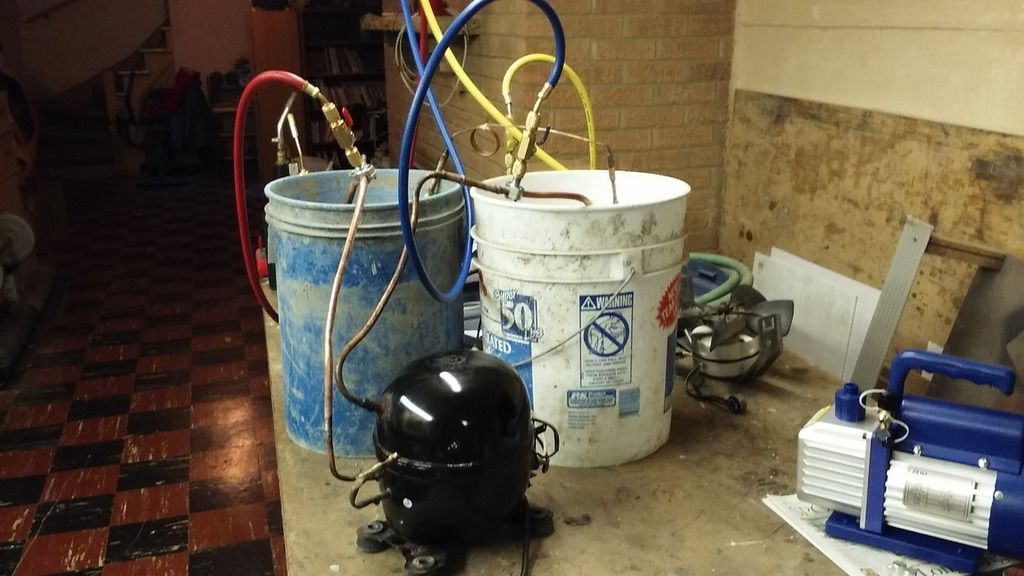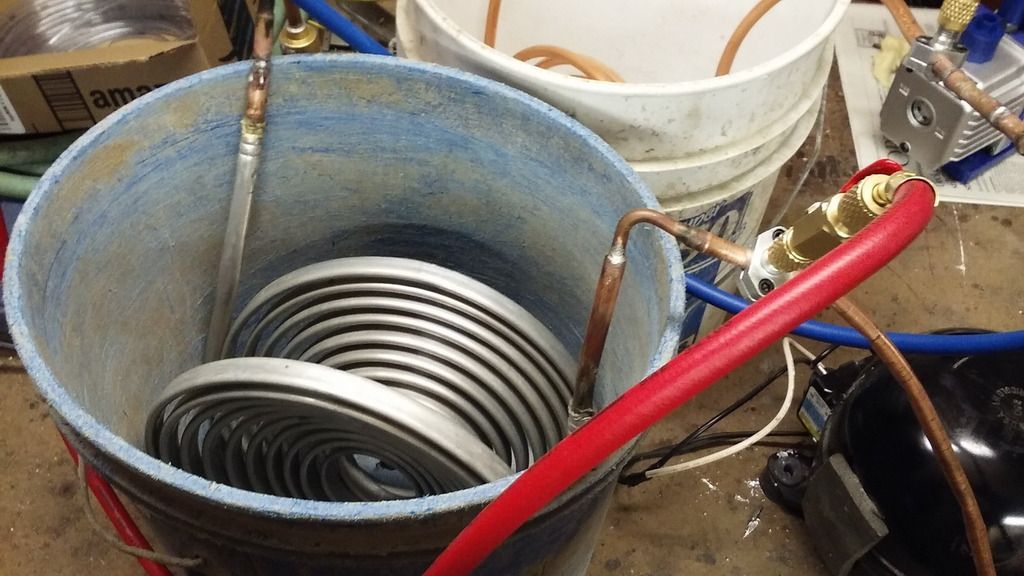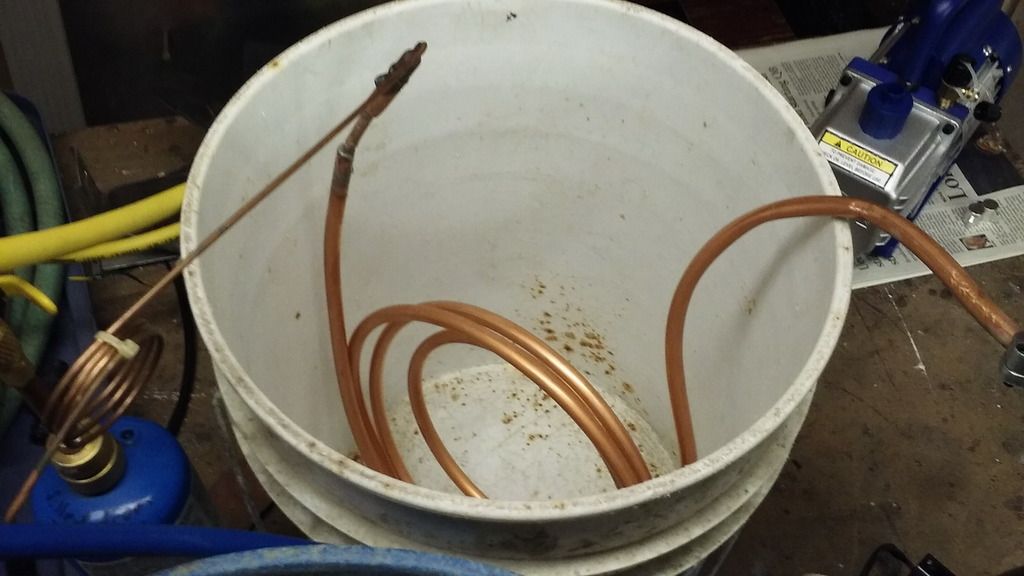
 |
|
|
#1 |
|
Helper EcoRenovator
Join Date: May 2016
Location: SE Wisconsin
Posts: 55
Thanks: 3
Thanked 14 Times in 10 Posts
|
I am about to start a small heat-pump water heater project. It will be very small because I am new to this type of development, so a small first step. I found a 2.5 gal 120v electric water heater on craigslist which I may buy tomorrow.
I intend to mount it in my basement under the kitchen to feed the kitchen sink and dishwasher. We waste a lot of hot water waiting for it to get from the water heater through 3/4 copper pipe through a low flow faucet. The water is usually just barely warm by the time your done washing your hands or rinsing a dish. So this will get hot water to the faucet faster with less wasted heat. I have a dehumidifier which will donate the compressor. Then I'd like to try to make a passive evaporator. It would be a small tank of water/anti-freeze. It could have some fins welded on to increase surface area. My basement is around 50F in winter and 70F in summer. For the kitchen faucet I am thinking 95/100F would be hot enough. Right now the cold water coming into the house is 53F. Anyway, I am new to the forum and wanted to start a thread so I could share what I learn and learn from you. Also, I never heard of a heat pump water heater before reading about it here, so thanks for that. |
|
|

|
|
|
#2 | |
|
Supreme EcoRenovator
Join Date: Mar 2009
Location: Portland, OR
Posts: 4,004
Thanks: 303
Thanked 724 Times in 534 Posts
|
Quote:
Your project sounds very doable. Your tank size is quite small, but it will be interesting to see how it works out. You will need specialized tools for the job. jeff5may is currently doing a similar hack, and he has listed the tools. The tools don't need to be new, and you can fudge a bit here and there. [* jeff5may is using an Oxy-Map gas brazing rig which is great, but a simple map gas torch will work at lower cost *]  $40 at Walmart You will need to be able to braze copper, absolutely not solder. In the refrigeration trade they call it soldering, but it really is brazing. Possibly, jeff5may might expand on that in his project. If your de-humidifier uses R134a, stick with that. If it uses R22, propane (camping gas) will work extremely well, but it is highly flammable so become aware of all the dangers and all the work-arounds. For a project like yours, select the very smallest compressor you can possibly find. De-humidifiers are rated in pints-per-day, in your case, smaller is better. Be aware that your compressor will have a very thin tube called the cap tube (capillary tube) that is perfectly matched to your compressor. If you use the cap tube that came with your compressor, your project will be greatly simplified, and your success more easily assured. Take and post loads of photos as you go along, and we will be able to best advise you. Good luck!!! -AC_Hacker
__________________
I'm not an HVAC technician. In fact, I'm barely even a hacker... Last edited by AC_Hacker; 05-12-16 at 11:39 AM.. |
|
|
|

|
|
|
#3 |
|
Helper EcoRenovator
Join Date: May 2016
Location: SE Wisconsin
Posts: 55
Thanks: 3
Thanked 14 Times in 10 Posts
|
Thanks for the advice. I do have an oxy-acetaline torch so I will get some silver solder and do it like you say. But I had planned on solder since it has a melt temp of 360F which I thought would be good enough.
I did get this tinny water heater today and will post photos after I build a shelf and plumb it up. |
|
|

|
|
|
#4 |
|
Supreme EcoRenovator
|
The acetylene-oxygen is almost too hot for brazing small piping...use a short flame and a smaller tip on this stuff. Especially on piping smaller than 1/2 inch. I use the copper phosphorus flat rods on everything I can. It's a lot cheaper than the sta-silv and is self-fluxing. With the sta-silv, you have to use flux or your joints will tarnish and be brittle.
Do not use tin (plumbing/electronic) solder on any of the refrigeration circuit at all! It isn't strong enough to withstand the high pressure and vibration. It will taint the correct metals with oxides of lead and/or antimony. Keep that stuff for water pipes and electrical connections. Good luck and take lots of pics. Last edited by jeff5may; 05-18-16 at 08:42 AM.. Reason: soelling |
|
|

|
|
|
#5 |
|
Helper EcoRenovator
Join Date: May 2016
Location: SE Wisconsin
Posts: 55
Thanks: 3
Thanked 14 Times in 10 Posts
|
Yesterday I made a shelf in the basement under the kitchen sink. Today I plumbed in the little heater. I installed valves so the water flow can be easily returned to using the main water heater and the mini heater can be removed for mods. Right now its running as an electric heater. I have it plugged into a watt meter and will monitor energy until I get the heat pump made.
|
|
|

|
|
|
#6 |
|
Helper EcoRenovator
Join Date: May 2016
Location: SE Wisconsin
Posts: 55
Thanks: 3
Thanked 14 Times in 10 Posts
|
|
|
|

|
|
|
#7 | |
|
Helper EcoRenovator
Join Date: May 2016
Location: SE Wisconsin
Posts: 55
Thanks: 3
Thanked 14 Times in 10 Posts
|
Quote:
I will practice using this on copper.  |
|
|
|

|
|
|
#8 |
|
Supreme EcoRenovator
|
That flux will work fine, but you only have to use it with the silver alloy:
Airgas - HAR4031 - 1/16" Harris® Safety-Silv® 40 High Silver Brazing Alloy Wire 1 Troy Ounce Pack (Prices are subject to change without notice due to raw materials cost volatility)  The CuP rods are flat and will mix well with the Safety-silv: Airgas - RAD64001758 - .050" X 1/8" Diameter Radnor® by Harris® Stay-Silv® 5 Silver Solder Job Pak (prices are subject to change without notice due to raw materials cost volatility) If you are joining copper to copper, the bare bronze(CuP) rods work well without flux. This eliminates chance of contamination and the need for flux removal. You can use the white flux with it if you want to, but inert shielding gas is still needed on the inside of the piping to prevent smut formation (another form of contamination). If you have brazed steel or aluminum before, this process is (much) easier than either of them. Even brazing copper to bronze or brass is easier with the silver alloy. Last edited by jeff5may; 05-18-16 at 10:43 AM.. |
|
|

|
|
|
#9 |
|
Helper EcoRenovator
Join Date: May 2016
Location: SE Wisconsin
Posts: 55
Thanks: 3
Thanked 14 Times in 10 Posts
|
Thanks for the tips on silver solder, I will get those materials. As for inert gas, can I use the c25 that I have for my mig welder. It is 75% argon with 25% CO2. I am thinking I would make an adapter to attach the gas hose to whatever I am brazing then flow gas through the inside of the tubes being brazed.
|
|
|

|
|
|
#10 |
|
Helper EcoRenovator
Join Date: May 2016
Location: SE Wisconsin
Posts: 55
Thanks: 3
Thanked 14 Times in 10 Posts
|
I did an experiment with materials I have. I learned that I have a lot to learn.
I acquired 2 old dehumidifiers, I took one apart to experiment with. I am saving the other to use for my finished heat pump. First I recovered the r22 into an empty propane bottle. Then I reassembled like this.  I used the Alum evap coil as the condensor. I used about 9 feet of 3/8 cu tube as the evaporator. I put each in a bucket with 4 gal of water.   I charged it with propane and it did not work so good. It appears to me that the evaporator did not have nearly enough capacity. It got cold, but so did the compressor, there must have been liquid getting back to the compressor and vaporizing in the compressor. So for now I am giving up on using a bucket of water as a heat source. Next I will set up a finned evaporator with a fan to see if I can get that to work. I didn't take good data because I could see I was way off. When I get better results I will post data. |
|
|

|
 |
|
|